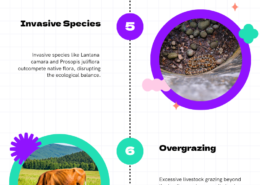What are some practical ways individuals can reduce their carbon footprint in daily life?
India’s natural vegetation is incredibly diverse, but it faces several significant threats. Here are the major threats to vegetation in India, which you can use to create an infographic: 1. Deforestation Causes: Logging, agriculture, urbanization, and infrastructure development. Impact: Loss of habiRead more
India’s natural vegetation is incredibly diverse, but it faces several significant threats. Here are the major threats to vegetation in India, which you can use to create an infographic:
1. Deforestation
- Causes: Logging, agriculture, urbanization, and infrastructure development.
- Impact: Loss of habitat, reduction in biodiversity, and disruption of ecosystems.
2. Urbanization
- Causes: Expansion of cities and towns.
- Impact: Conversion of natural landscapes into urban areas, leading to habitat fragmentation and loss.
3. Pollution
- Causes: Industrial activities, vehicular emissions, and agricultural runoff.
- Impact: Soil degradation, water contamination, and adverse effects on plant health.
4. Climate Change
- Causes: Global warming, changes in precipitation patterns, and extreme weather events.
- Impact: Altered growth patterns, increased vulnerability to pests and diseases, and shifts in vegetation zones.
5. Invasive Species
- Examples: Lantana camara, Chromolaena odorata, and Prosopis juliflora.
- Impact: Competition with native species, alteration of habitats, and disruption of ecological balance.
6. Overgrazing
- Causes: Livestock grazing beyond the carrying capacity of the land.
- Impact: Soil erosion, loss of plant cover, and degradation of grasslands.
7. Mining
- Causes: Extraction of minerals and resources.
- Impact: Destruction of vegetation, soil erosion, and pollution of water bodies.
8. Overexploitation
- Causes: Unsustainable harvesting of timber, medicinal plants, and other forest products.
- Impact: Depletion of resources and loss of biodiversity.
9. Habitat Destruction
- Causes: Infrastructure projects, agriculture, and human settlements.
- Impact: Loss of natural habitats, fragmentation, and decline in wildlife populations.
10. Decline of Pollinators
- Causes: Pesticide use, habitat loss, and climate change.
- Impact: Reduced pollination, affecting plant reproduction and crop yields.
These threats collectively pose a significant challenge to the conservation of India’s natural vegetation. Addressing these issues requires coordinated efforts in conservation, sustainable practices, and policy implementation.
See less

Individuals can significantly reduce their carbon footprint through several practical steps: 1. Transportation: Use public transportation, carpool, bike, or walk instead of driving alone. If possible, switch to electric or hybrid vehicles. 2. Energy Consumption: Reduce energy use at hoRead more
Individuals can significantly reduce their carbon footprint through several practical steps:
1. Transportation: Use public transportation, carpool, bike, or walk instead of driving alone. If possible, switch to electric or hybrid vehicles.
2. Energy Consumption: Reduce energy use at home by turning off lights and appliances when not in use, using energy-efficient bulbs, and investing in energy-efficient appliances. Consider installing solar panels.
3. Diet: Adopt a plant-based diet or reduce meat and dairy consumption. Local, seasonal produce often has a lower carbon footprint.
4. Waste Reduction: Reduce, reuse, and recycle. Avoid single-use plastics, compost organic waste, and support products with minimal packaging.
5. Water Conservation: Use water-saving fixtures, fix leaks, and be mindful of water use in daily activities.
6. Shopping Habits: Buy less, choose sustainable and eco-friendly products, and support companies with green practices.
7. Home Insulation: Improve home insulation to reduce heating and cooling energy needs.
8. Renewable Energy: If possible, switch to a renewable energy provider.
By integrating these actions into daily routines, individuals can make a significant impact on reducing their carbon footprint and contribute to a more sustainable future.
See less